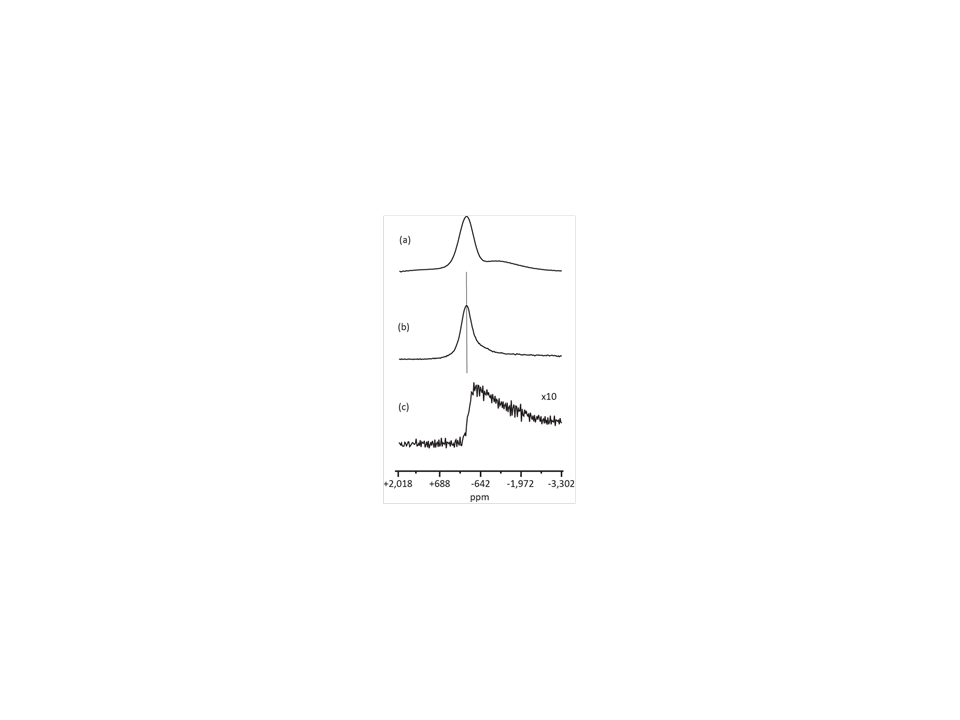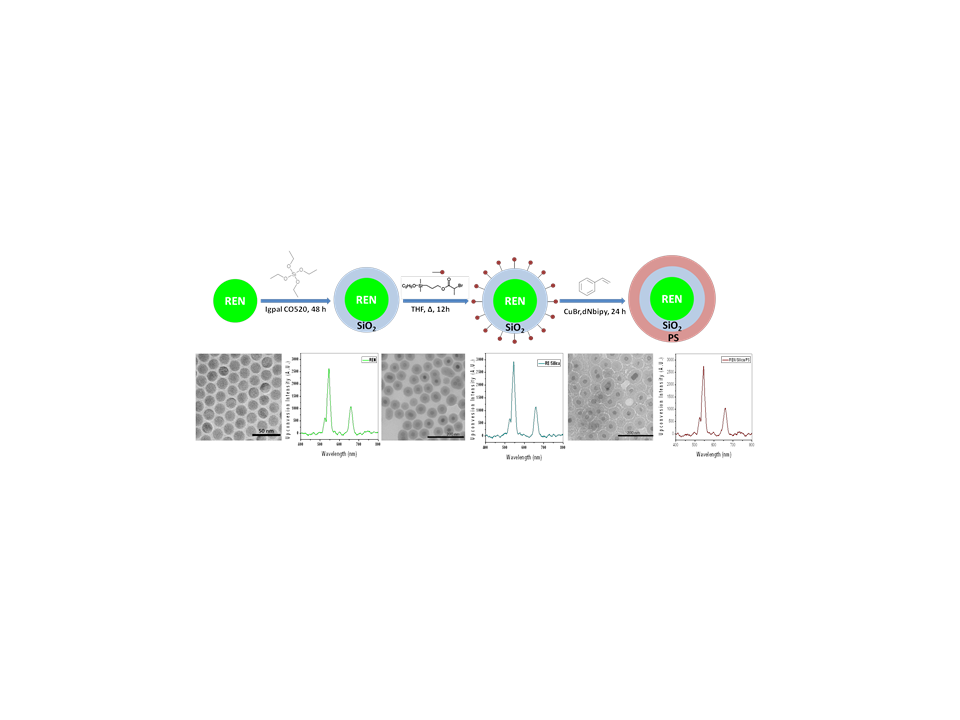58th Annual Report on Research 2013 Under Sponsorship of the ACS Petroleum Research Fund
Reports: ND1050892-ND10: Surface Supported Rare Earth Element Based Nanomaterials as a Composite in Solar Cell Electrodes
Gang-yu Liu, PhD, University of California (Davis)
Matthew Augustine, University of California (Davis)
Overview
The PRF support enables the team to pursue rare earth based nanomaterials (RENs) for solar cell applications. This research takes advantage of RENs unique optical properties, that is, absorption in the near infrared (NIR), and emission visible photons via upconversion (UC). The RENs can be placed at the rear of, for example, photovoltaic cells to harvest NIR radiation. The photoluminescent photons can then be reflected back to the cell to improve the overall photoelectrical conversion efficiency. During the first grant year (2011-2012), we demonstrated that incorporation of rare earth fluoride phosphors indeed improve device performance, such as higher efficiency in solar water splitting by hematite films.
During the 2nd grant year (2012-2013), we have systematically investigated the mechanism of upconversion efficiency by revealing the impact of local structure and environment. In addition, we have made new series of core/shell materials of upconversion nanomaterials to pave the way for integration to actual devices.
Progress in year 2 (2012-2013)
NMR Characterization of Nanocrystalline Yb and Er Doped-NaYF4 Phosphors
 Solid state NMR spectroscopy was applied to NaY1-xYbxErYF4 nanoparticles for the first time. Although the 89Y NMR spectrum for these phosphors could not be measured, the 19F NMR spectrum and the 19F and 23Na relaxation properties in these solids were measured and found to correlate well with Ln3+ cation content. The combination of an understanding of the 19F NMR spectrum involving scalar contact or hyperfine shifts that yield a 0 ppm 19F spectator peak in the x ≤ 0.3 and y ≤ 0.03 range with simple statistical analysis suggests that the 19F relaxation rate is sensitive to Yb3+ - Er3+ interactions, as shown in Figure 1. These interactions are likely in the form of ErYbn or YbErn clusters and are central to optical up-conversion in a bulk phase theoretical effort and in an empirical study in confined phase. In addition to helping understand the NMR measurements, the statistical analysis also predicts the x = 0.2 Yb3+ and y = 0.03 Er3+ content that corresponds to the best performing bulk and confined optical up-conversion of these fluoride phosphors. In the bulk phase these x and y values appear to be motivated by a minimum Yb3+ - Yb3+ interaction distance, specifically between the third and fourth nearest neighbors. In the confined phase, the superior optical up-conversion x and y values appear to be controlled by a tradeoff between ErYbn and YbErn content via a violation in the detailed balance hypothesis. In both phases, the Er3+ content is reduced in comparison to Yb3+ because Er3+ produces more electronic and magnetic lattice disruption. The ratio of Yb3+ and Er3+ room temperature, ground state magnetic moments was used to estimate y in terms of x and to provide values consistent with experiment.
Solid state NMR spectroscopy was applied to NaY1-xYbxErYF4 nanoparticles for the first time. Although the 89Y NMR spectrum for these phosphors could not be measured, the 19F NMR spectrum and the 19F and 23Na relaxation properties in these solids were measured and found to correlate well with Ln3+ cation content. The combination of an understanding of the 19F NMR spectrum involving scalar contact or hyperfine shifts that yield a 0 ppm 19F spectator peak in the x ≤ 0.3 and y ≤ 0.03 range with simple statistical analysis suggests that the 19F relaxation rate is sensitive to Yb3+ - Er3+ interactions, as shown in Figure 1. These interactions are likely in the form of ErYbn or YbErn clusters and are central to optical up-conversion in a bulk phase theoretical effort and in an empirical study in confined phase. In addition to helping understand the NMR measurements, the statistical analysis also predicts the x = 0.2 Yb3+ and y = 0.03 Er3+ content that corresponds to the best performing bulk and confined optical up-conversion of these fluoride phosphors. In the bulk phase these x and y values appear to be motivated by a minimum Yb3+ - Yb3+ interaction distance, specifically between the third and fourth nearest neighbors. In the confined phase, the superior optical up-conversion x and y values appear to be controlled by a tradeoff between ErYbn and YbErn content via a violation in the detailed balance hypothesis. In both phases, the Er3+ content is reduced in comparison to Yb3+ because Er3+ produces more electronic and magnetic lattice disruption. The ratio of Yb3+ and Er3+ room temperature, ground state magnetic moments was used to estimate y in terms of x and to provide values consistent with experiment.
Figure 1. (Ultra-wide line 19F NMR spectra for a-NaY0.7Yb0.3F4 in (a), a-NaY0.97Er0.03F4 in (b), and a-NaY0.8Er0.2F4 in (c) recorded in this study.
Atomic Transfer Radical Polymerization from Nanophors of Rare Earth Fluoride
In order to optimize optical stability and improve capability to integrate into a real device, we have synthesized nanostructures of NaYF4:Yb3+/Er3+ with a SiO2 shell, and then capped the outer shell with polystyrene, as shown in Figure 2. As shown in the synthesis scheme: rare earth upconvension nanocrystal cores were prepared by thermo decomposition method of rare earth trifluoroacetic salt. Then, silica coating on REN surface wss carried out by using TEOS hydrolysis in reverse micelles solution with Igepal CO520 surfactant. Next, the organosiloxane surface initiator 3-(2-bromoisobutyryl)propyl dimethylethoxysilane (BIDS) was synthesized and then coupled with the silica surface. Finally, the initiator-modified nanoparticles were used as macro-initiators for the ATRP polymerization of styrene on REN surfaces catalyzed by CuBr.
Figure 2 revealed the size of these nanomaterials: 20 nm phosphor cores covered by 19 nm silica shell. The polymer capping ranges 4-6 nm, with molecular weight measured Mn =1.80 ×104 g/mol, Mw =1.94 ×104 g/mol. The introduction of the SiO2/polymer shell serves functions of (a) stabilizing phosphors, (b) improving and stabilizing optical emission (see spectral intensity in Fig. 2), and (c) enabling further functionalization for materials integration.
Figure 2. Top: Schematic diagram of a generic design to prepare REN/Silica/PS composite materials. Bottom: TEM micrograph in conjunction with upconversion fluorescence emission spectrum of the nanoparticles synthesized at each step of the schematic diagram.
 This method of polymerization and coating has intrinsic advantages of (a) high homogeneity in polymer structures; (b) being generic and useable with a wide range of polymeric materials and functionalities; and (c) a high degree of control of the thickness, and distribution of the polymer coatings.
This method of polymerization and coating has intrinsic advantages of (a) high homogeneity in polymer structures; (b) being generic and useable with a wide range of polymeric materials and functionalities; and (c) a high degree of control of the thickness, and distribution of the polymer coatings.
Figure 3. Correlation of AFM topographic features to upconversion luminescence. (A) AFM and (B) luminescence images over the same region of a composite nanoscale surface structures. (C) Overlay of the (A) and (B). (D) Upconversion luminescence spectrum.
To demonstrate the feasibility to integrated these RENs, arrays of ordered β-NaYF4:Yb,Er nanorings inlaid in an OTS matrix were fabricated using nanosphere lithography. Combined AFM, NSOM, and far-field microscopy and spectroscopy were utilized to characterize their structure in correlation to the photoluminescent properties at single feature and single particle level, as shown in Figure 3. The combined capabilities of imaging and spectroscopy at single particle level are critical in characterizing structure in correlation with the upper conversion luminescent properties. This work lays the foundation for the construction of more complex structures such as multiple REN materials or 3D nanostructures.
Impact of the project
The support from ACS PRF enabled us to partially support a postdoctoral researcher and 2 graduate students, as well as establish collaborations with both Boston University and Peking University in China, through which US researchers in UCD could access the rich rare earth resources in China. 3 publications are generated (2 on ACS Nano, and 1 on JPCL), and two manuscripts will be submitted soon. We plan to further this promising lead by further improving photoemission efficiency, taking advantages of our synthesis protocols and local structural information directed from this investigation.
Copyright © 2014 American Chemical Society












